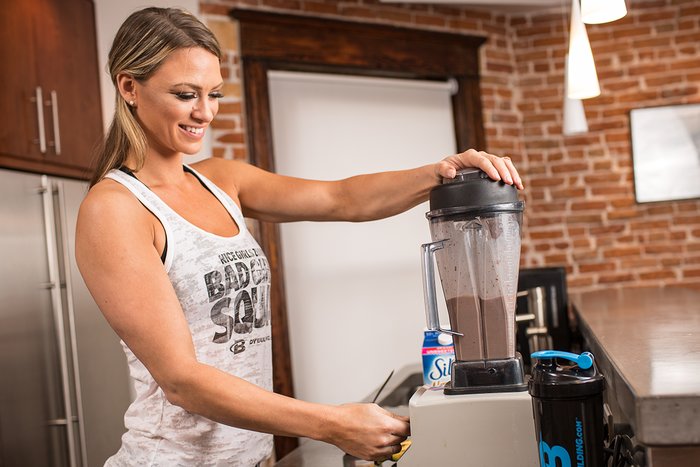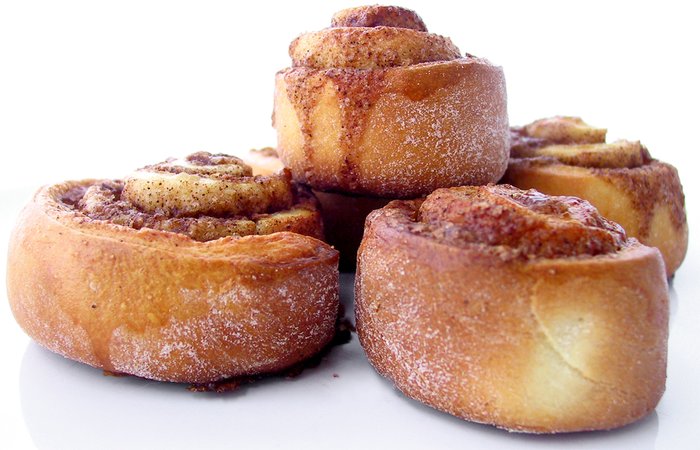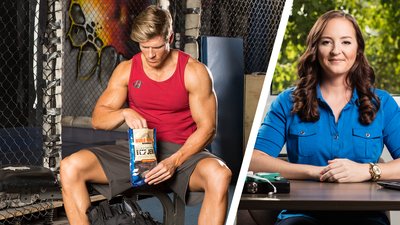Q. Does The Post-Workout "Anabolic Window" Even Exist, And What Supplements Can I Take To Take To Optimize Pre- And Post-Workout Nutrition?
Ah, the anabolic window—easily one of my favorite windows, and easily one of the most hotly debated topics in sports nutrition over the last several years.
I admit that when I was in grad school, I used to preach the importance of consuming adequate amounts of carbs and protein within 45 minutes of finishing a workout. "Miss the anabolic window, and you might as well kiss your gains goodbye!" I'd tell people.
Jump forward five years, and my point of view has changed...to an extent. While I still think it's important to fuel your body post-workout, I no longer believe you somehow miss out on an opportunity for growth if you don't eat immediately after your last set.
Why the change of heart? For one, research methods have drastically improved, and we're armed with better information. Early studies often used subjects in a fasted state to look at the effects of nutrient timing on changes in body composition, strength, and muscle size. Because fasting itself will put your body in a catabolic state, eating immediately after a workout is crucial for promoting muscle protein synthesis and glycogen storage.
But unless you train at 5 a.m. on an empty stomach, there's less urgency when it comes to consuming your post-workout meal. Eating as few as 20 grams of protein as part of your pre-workout meal can significantly elevate the delivery of amino acids to your muscles for up to 2-3 hours post-workout.[1] So even if you delay your post-workout meal for a couple hours, your body is still using the amino acids from your pre-workout meal to stimulate maximal growth and recovery.

It certainly doesn't hurt to throw back a protein shake immediately after your workout, but you can still gain a substantial amount of strength and size even when delaying post-workout nutrition.
If you start your training session more than four hours after your last meal, you definitely want to consume 25-30 grams of protein immediately after your workout to help reverse the catabolic state in your body and maximize muscle growth. On the other hand, consuming a small pre-workout meal before you train can delay the timing of your next meal, which might come in handy if you have to rush to a meeting, quickly get ready for work, or run a few errands.
Another issue with some of the older studies is the lack of dietary control. Several early studies controlled only for protein and carb intake immediately before and after training, paying little attention to what was being consumed the rest of the day. This muddies the water, making it unclear whether improvements in strength and muscle size were the result of protein timing or an increase in protein and/or carbohydrate intake throughout the rest of the day.
If your goal is maximizing rates of muscle gain, current findings support the broad objective of meeting total dailyprotein and carbohydrate needs (assuming you're not training in a fasted state).[2-4]
It certainly doesn't hurt to throw back a protein shake immediately after your workout, but you can still gain a substantial amount of strength and size even when delaying post-workout nutrition. Rather than focusing on this imaginary window of special growth, plan your meals so that you consume 25-30 grams of protein every few hours, and consume adequate amounts of carbs throughout the day to keep your energy levels high in the gym.
As for additional supplements that may enhance your pre- and post-workout nutrition, creatine, BCAAs, and citrulline malate can all be added to either your pre- or post-workout drink to enhance muscle strength, size, and recovery.
What Does Research Say About The Effects Of The Dietary Fiber Glucomannan On Weight Loss And Blood-Glucose Control?
Glucomannan has received a lot of attention lately for its potential use as a weight-loss aid. This water-soluble dietary fiber has a long history of use in herbal mixtures and foods like tofu and shirataki noodles, but it's now available as an over-the-counter supplement for weight loss.
Like other soluble fiber—oats, guar gum, pectin, and psyllium—glucomannan works by absorbing liquids in the stomach, causing it to increase in size and delay the exit of food from your stomach. This in turn can help to increase satiety, reduce body weight, reduce the rise in glucose levels of a post-carb meal, and increase the elimination of cholesterol-containing bile salts.

If you want to give glucomannan a try, I recommend taking 1 gram with about 8 ounces of water before breakfast, lunch, and dinner.
Several clinical trials have investigated the impact of glucomannan on body weight, blood glucose levels, and cholesterol, and have found it to be beneficial for the most part.[5-7] However, studies looking at its effect on blood pressure do not appear to be impacted by supplementation.
I do want to stress that these studies have been done using clinical populations. Patient populations included those with type 2 diabetes, those who were overweight or obese, and those with high cholesterol and high blood pressure values. It's tough to say whether an apparently healthy individual would experience the same benefits, but it does appear to be safe and tolerable, with flatulence and diarrhea being some of the more common side effects. (You might want to refrain from using before a date or social outing!)
If you want to give glucomannan a try, I recommend taking 1 gram with about 8 ounces of water before breakfast, lunch, and dinner. Like most weight-loss methods, glucomannan may be more effective when combined with a reduced-calorie diet and a training program that includes both resistance exercise and moderate cardio.
Will Using Artificial Sweeteners In My Diet Cause Me To Crave And Eat More Sweets?
Artificial sweeteners like aspartame, saccharin, stevia, and sucralose are commonly used to sweeten food and drink without adding calories. Their history of use has been accompanied by debate and disagreement about whether their consumption might increase the risk of becoming overweight and obese.
Before we get into the effects of low-calorie sweeteners on your waistline, I do want to discuss their safety. There are numerous reports and websites that claim artificial sweeteners are toxic to your body because they're a chemical. Just because something's labeled as a "chemical" doesn't make it inherently bad for you. Take, for example, lecithin, pectin, guar gum, and propionic acid. These are all common chemicals found in foods and have no reported side effects. You probably didn't even know you were consuming them.
Put simply, there's no available data on human subjects showing that consumption of artificial sweeteners can lead to diseases like diabetes and cancer. It's safe to say that if you include them in your diet in moderation, you won't grow a third eye or an extra limb.

Some argue that substituting artificial sweeteners for the "real deal" may cause you to crave additional sugary snacks, or cause you to increase your energy intake at the next meal.
But the question at hand is whether artificial sweeteners cause you to crave more sweets and hinder your weight-loss goals. Some argue that substituting artificial sweeteners for the "real deal" may cause you to crave additional sugary snacks, or cause you to increase your energy intake at the next meal. "I had a Diet Coke with lunch, so I can eat this cupcake for dessert" is one such possible rationalization. However, a recent review article published in the International Journal of Obesity found that both calorie intake and body weight decreased with the consumption of artificial sweeteners relative to sugar.[8]
A review article from 2014 observed similar findings, with the authors concluding that substituting a low-calorie sweetener in place of a regular-calorie version can result in a moderate loss of body weight. Furthermore, it may be a useful dietary tool to improve compliance with weight-loss or weight-maintenance dietary programs.[9]
Drinking liquids flavored with low-calorie sweeteners has also been shown to have zero impact on subsequent calorie intake when compared to water. For some, the exposure to sweetness may be a bit dangerous, because it could create a preference for sweet foods, but multiple studies have shown that acute exposure to sweetness—say, drinking water flavored with Crystal Light—can decrease the desire for additional sweet items.[10-12]
What's more, a study published in the American Journal of Clinical Nutrition found that subjects drinking a beverage flavored with a low-calorie sweetener reduced their consumption of dessert items compared to those drinking water.[13]
You may dislike artificial sweeteners and see them as the root of all evil, but if you're looking for some help to curb your cravings, or just want to add a little flavor to your otherwise boring bottled water, you're more than safe adding artificial sweeteners into your diet!
Do you have a question for Dr. Kendall? Place it in the comments section below; it might be chosen for an upcoming installment of Ask the Science Chick!
References
- Tipton, K. D., Elliott, T. A., Cree, M. G., Aarsland, A. A., Sanford, A. P., & Wolfe, R. R. (2007). Stimulation of net muscle protein synthesis by whey protein ingestion before and after exercise. American Journal of Physiology-Endocrinology and Metabolism, 292(1), E71-E76.
- Hoffman, J. R., Ratamess, N. A., Tranchina, C. P., Rashti, S. L., Kang, J., & Faigenbaum, A. D. (2009). Effect of protein-supplement timing on strength, power, and body-composition changes in resistance-trained men. International Journal of Sport Nutrition, 19(2), 172.
- Erskine, R. M., Fletcher, G., Hanson, B., & Folland, J. P. (2012). Whey protein does not enhance the adaptations to elbow flexor resistance training. Medicine and Science in Sports and Exercise, 44(9), 1791-1800.
- Mielke, M., Housh, T. J., Malek, M. H., Beck, T. W., Schmidt, R. J., Johnson, G. O., & Housh, D. J. (2009). The Effects of Whey Protein and Leucine Supplementation on Strength, Muscular Endurance, and Body Composition During Resistance Training. Journal of Exercise Physiology Online, 12(5).
- Zhang, M. Y., Huang, C. Y., Wang, X., Hong, J. R., & Peng, S. S. (1990). The effect of foods containing refined Konjac meal on human lipid metabolism. Biomedical and Environmental Sciences: BES, 3(1), 99-105.
- Vita, P. M., Restelli, A., Caspani, P., & Klinger, R. (1992). Chronic use of glucomannan in the dietary treatment of severe obesity. Minerva Medica, 83(3), 135-139.
- Doi, K., Matsuura, M., Kawara, A., Uenoyama, R., & Baba, S. (1981). Effect of glucomannan (konjac fiber) on glucose and lipid metabolism in normal and diabetic subjects. Genetic Environmental Interaction in Diabetes Mellitus. Amsterdam: Excerpta Medica, 306-312.
- Rogers, P. J., Hogenkamp, P. S., De Graaf, C., Higgs, S., Lluch, A., Ness, A. R., ... & Mela, D. J. (2015). Does low-energy sweetener consumption affect energy intake and body weight? A systematic review, including meta-analyses, of the evidence from human and animal studies. International Journal of Obesity, [epub ahead of print.]
- Miller, P. E., & Perez, V. (2014). Low-calorie sweeteners and body weight and composition: a meta-analysis of randomized controlled trials and prospective cohort studies. The American Journal of Clinical Nutrition, 100(3), 765-777.
- Weenen, H., Stafleu, A., & De Graaf, C. (2005). Dynamic aspects of liking: post-prandial persistence of sensory specific satiety. Food Quality and Preference, 16(6), 528-535.
- Snoek, H. M., Huntjens, L., van Gemert, L. J., de Graaf, C., & Weenen, H. (2004). Sensory-specific satiety in obese and normal-weight women. The American Journal of Clinical Nutrition, 80(4), 823-831.
- Griffioen-Roose, S., Finlayson, G., Mars, M., Blundell, J. E., & de Graaf, C. (2010). Measuring food reward and the transfer effect of sensory specific satiety. Appetite, 55(3), 648-655.
- Piernas, C., Tate, D. F., Wang, X., & Popkin, B. M. (2013). Does diet-beverage intake affect dietary consumption patterns? Results from the Choose Healthy Options Consciously Everyday (CHOICE) randomized clinical trial. The American Journal of Clinical Nutrition, 97(3), 604-611.

